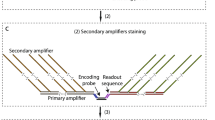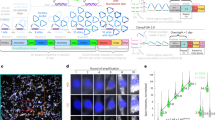Abstract
We have used high-density oligonucleotide probe arrays (chips) for bacterial transcript imaging. We designed a chip containing probes representing 106 Hemophilus influenzae genes and 100 Streptococcus pneumoniae genes. The apparent lack of polyadenylated transcripts excludes enrichment of mRNA by affinity purification and we thus used total, chemically biotinylated RNA as hybridization probe. We show that hybridization of Streptococcus RNA to a chip allows simultaneous quantification of the transcript levels. The sensitivity was found to be in the range of one to five transcripts per cell. The quantitative chip results were in good agreement with conventional Northern blot analysis of selected genes. This technology allows simultaneous and quantitative measurement of the transcriptional activity of entire bacterial genomes on a single oligonucleotide probe array.
This is a preview of subscription content, access via your institution
Access options
Subscribe to this journal
Receive 12 print issues and online access
$209.00 per year
only $17.42 per issue
Buy this article
- Purchase on Springer Link
- Instant access to full article PDF
Prices may be subject to local taxes which are calculated during checkout
Similar content being viewed by others
References
Mahan, M.J., Slauch, J.M., and Mekalanos, J.J. 1993. Selection of bacterial virulence genes that are specifically induced in host tissues. Science 259: 686–688.
Liang, P. and Pardee, A.B. 1992. Differential display of eukaryotic messenger RNA by means of the polymerase chain reaction. Science 257: 967–971.
Fislage, R., Berceanu, M., Humboldt, Y., Wendt, M., and Oberender, H. 1997. Primer design for a prokaryotic differential display RT-PCR. Nucl. Acids Res. 25: 1830–1835.
Plum, G., and Clark-Curtiss, J.E. 1994. Induction of Mycobacterium avium gene expression following phagocytosis by human macrophages. Infect. Immun. 62: 476–483.
Chuang, S.E., Daniels, D.L., and Blatner, F.R. 1993. Global regulation of gene expression in Escherichia coli. J. Bacteriol. 175: 2026–2036.
Schena, M., Shalon, D., Davis, R.W.,and Brown, P.O. . 1995. Quantitative monitoring of gene expression patterns with a complementary DNA microarray. Science 270: 467–470.
Shalon, D., Smith, S.J., and Brown, P.O. 1996. A DNA microarray system for analyzing complex DNA samples using two-color fluorescent probe hybridization. Genome Research. 6: 639–645.
Pease, A.C., Solas, D., Sullivan, E.J., Cronin, M.T., Holmes, C.R, Fodor, S.P.A., et al. 1994. Light-directed oligonucleotide arrays for rapid DNA sequence analysis Proc. Natl. Acad. Sci. USA 91: 5022–5026.
Lockhart, D.J., Dong, H., Byrne, M.C., Follettie, M.T., Gallo, M.V., Chee, M.S., et al. 1996. Expression monitoring by hybridization to high-density oligonucleotide arrays. Bio/Technology 14: 1675–1680.
Wodicka, L., Dong, H., Mittmann, M., Ho, M.-H., and Lockhart, D. 1997. Genome-wide expression monitoring in Saccnaromyces cerevisiae. Bio/Technology 15: 1359–1367.
Levenson, C., Watson, R., and Sheldon, E.L 1990. Biotinylated psoralen derivative for labeling nucleic acid hybridization probes. Methods Enzymol. 184: 577–583.
Cimono, G.D., Gamper, H.B., Isaacs, S.T., and Hearst, J.E. 1985. Psoralens as photoactive probes of nucleic acid structure and function: Organic chemistry, photochemistry, and biochemistry. Ann. Rev. Biochem. 54: 1151–1193.
Havarstein, L.S., Coomaraswamy, G., and Morrison, D.A. 1995. An unmodified heptadecapeptide pheromone induces competence for genetic transformation in Streptococcus pneumoniae. Proc. Natl. Acad. Sci. USA 92: 11140–11144.
Cheng, Q., Campbell, E.A., Naughton, A.M., Johnson, S., and Masure, H.R. 1997. The com locus controls genetic transformation in Streptococcus pneumoniae. Mol. Microbiol. 23: 683–692.
Mortier-Barriere, I., de Saizieu, A., Claverys, J.-P., and Martin, B. Competence-specific induction of recA is required for full recombination proficiency during transformation in Streptococcus pneumoniae. Mol. Microbiol. In press.
Author information
Authors and Affiliations
Rights and permissions
About this article
Cite this article
Saizieu, A., Certa, U., Warrington, J. et al. Bacterial transcript imaging by hybridization of total RNA to oligonucleotide arrays. Nat Biotechnol 16, 45–48 (1998). https://doi.org/10.1038/nbt0198-45
Received:
Accepted:
Issue Date:
DOI: https://doi.org/10.1038/nbt0198-45
This article is cited by
-
Tiling array study of MNNG treated Escherichia coli reveals a widespread transcriptional response
Scientific Reports (2013)
-
Novel concept microarray enabling PCR and multistep reactions through pipette-free aperture-to-aperture parallel transfer
BMC Biotechnology (2010)
-
In situ transcriptomic analysis of the globally important keystone N2-fixing taxon Crocosphaera watsonii
The ISME Journal (2009)
-
Genome-directed primers for selective labeling of bacterial transcripts for DNA microarray analysis
Nature Biotechnology (2000)
-
RNA expression analysis using a 30 base pair resolution Escherichia coli genome array
Nature Biotechnology (2000)



